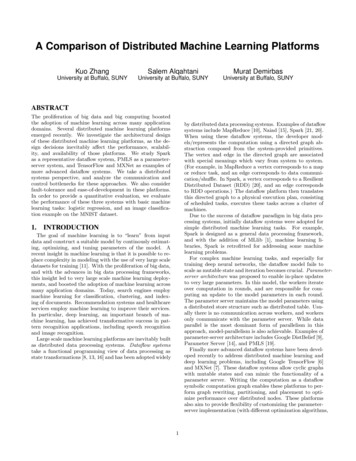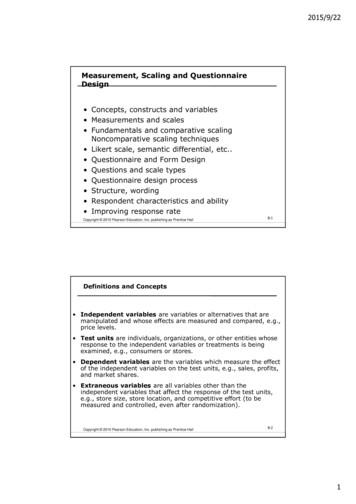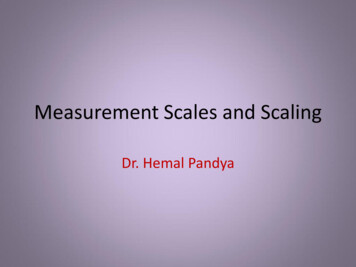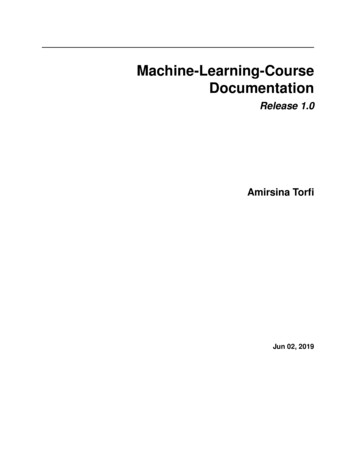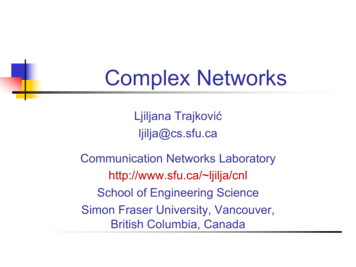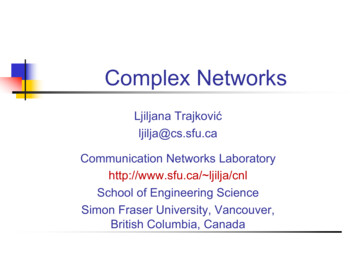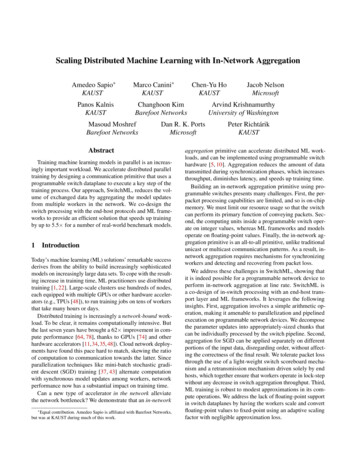
Transcription
Scaling Distributed Machine Learning with In-Network AggregationAmedeo Sapio KAUSTPanos KalnisKAUSTMarco Canini KAUSTChanghoon KimBarefoot NetworksMasoud MoshrefBarefoot NetworksDan R. K. PortsMicrosoftAbstractTraining machine learning models in parallel is an increasingly important workload. We accelerate distributed paralleltraining by designing a communication primitive that uses aprogrammable switch dataplane to execute a key step of thetraining process. Our approach, SwitchML, reduces the volume of exchanged data by aggregating the model updatesfrom multiple workers in the network. We co-design theswitch processing with the end-host protocols and ML frameworks to provide an efficient solution that speeds up trainingby up to 5.5 for a number of real-world benchmark models.1IntroductionToday’s machine learning (ML) solutions’ remarkable successderives from the ability to build increasingly sophisticatedmodels on increasingly large data sets. To cope with the resulting increase in training time, ML practitioners use distributedtraining [1, 22]. Large-scale clusters use hundreds of nodes,each equipped with multiple GPUs or other hardware accelerators (e.g., TPUs [48]), to run training jobs on tens of workersthat take many hours or days.Distributed training is increasingly a network-bound workload. To be clear, it remains computationally intensive. Butthe last seven years have brought a 62 improvement in compute performance [64, 78], thanks to GPUs [74] and otherhardware accelerators [11, 34, 35, 48]). Cloud network deployments have found this pace hard to match, skewing the ratioof computation to communication towards the latter. Sinceparallelization techniques like mini-batch stochastic gradient descent (SGD) training [37, 43] alternate computationwith synchronous model updates among workers, networkperformance now has a substantial impact on training time.Can a new type of accelerator in the network alleviatethe network bottleneck? We demonstrate that an in-network EqualChen-Yu HoKAUSTcontribution. Amedeo Sapio is affiliated with Barefoot Networks,but was at KAUST during much of this work.Jacob NelsonMicrosoftArvind KrishnamurthyUniversity of WashingtonPeter RichtárikKAUSTaggregation primitive can accelerate distributed ML workloads, and can be implemented using programmable switchhardware [5, 10]. Aggregation reduces the amount of datatransmitted during synchronization phases, which increasesthroughput, diminishes latency, and speeds up training time.Building an in-network aggregation primitive using programmable switches presents many challenges. First, the perpacket processing capabilities are limited, and so is on-chipmemory. We must limit our resource usage so that the switchcan perform its primary function of conveying packets. Second, the computing units inside a programmable switch operate on integer values, whereas ML frameworks and modelsoperate on floating-point values. Finally, the in-network aggregation primitive is an all-to-all primitive, unlike traditionalunicast or multicast communication patterns. As a result, innetwork aggregation requires mechanisms for synchronizingworkers and detecting and recovering from packet loss.We address these challenges in SwitchML, showing thatit is indeed possible for a programmable network device toperform in-network aggregation at line rate. SwitchML isa co-design of in-switch processing with an end-host transport layer and ML frameworks. It leverages the followinginsights. First, aggregation involves a simple arithmetic operation, making it amenable to parallelization and pipelinedexecution on programmable network devices. We decomposethe parameter updates into appropriately-sized chunks thatcan be individually processed by the switch pipeline. Second,aggregation for SGD can be applied separately on differentportions of the input data, disregarding order, without affecting the correctness of the final result. We tolerate packet lossthrough the use of a light-weight switch scoreboard mechanism and a retransmission mechanism driven solely by endhosts, which together ensure that workers operate in lock-stepwithout any decrease in switch aggregation throughput. Third,ML training is robust to modest approximations in its compute operations. We address the lack of floating-point supportin switch dataplanes by having the workers scale and convertfloating-point values to fixed-point using an adaptive scalingfactor with negligible approximation loss.
SwitchML integrates with distributed ML frameworks,such as PyTorch and TensorFlow, to accelerate their communication, and enable efficient training of deep neural networks(DNNs). Our initial prototype targets a rack-scale architecture, where a single switch centrally aggregates parameterupdates from serviced workers. Though the single switchlimits scalability, we note that commercially-available programmable switches can service up to 64 nodes at 100 Gbpsor 256 at 25 Gbps. As each worker is typically equipped withmultiple GPUs, this scale is sufficiently large to push thestatistical limits of SGD [32, 43, 50, 98].We show that SwitchML’s in-network aggregation yieldsend-to-end improvements in training performance of up to5.5 for popular DNN models. Focusing on a communicationmicrobenchmark, compared to the best-in-class collective library NCCL [77], SwitchML is up to 2.9 faster than NCCLwith RDMA and 9.1 than NCCL with TCP. While the magnitude of the performance improvements is dependent onthe neural network architecture and the underlying physicalnetwork speed, it is greater for models with smaller computeto-communication ratios – good news for future, faster DNNtraining accelerators.Our approach is not tied to any particular ML framework; we have integrated SwitchML with Horovod [89]and NCCL [77], which support several popular toolkits likeTensorFlow and PyTorch. SwitchML is openly available k bottlenecks in ML trainingIn the distributed setting, ML training yields a highperformance networking problem, which we highlight belowafter reviewing the traditional ML training process.2.1Training and all to all communicationSupervised ML problems, including logistic regression, support vector machines and deep learning, are typically solvedby iterative algorithms such as stochastic gradient descent(SGD) or one of its many variants (e.g., using momentum,mini-batching, importance sampling, preconditioning, variance reduction) [72, 73, 83, 90]. A common approach to scaling to large models and datasets is data-parallelism, wherethe input data is partitioned across workers.1 Training in adata-parallel, synchronized fashion on n workers can be seenas learning a model x Rd over input/training data D byperforming iterations of the form xt 1 xt ni 1 (xt , Dti ),where xt is a vector of model parameters2 at iteration t, (·, ·)is the model update function3 and Dti is the data subset used1 In this paper, we do not consider model-parallel training [28, 82], although that approach also requires efficient networking. Further, we focusexclusively on widely-used distributed synchronous SGD [1, 37].2 In applications, x is typically a 1, 2, or 3 dimensional tensor. To simplifynotation, we assume its entries are vectorized into one d dimensional vector.3 We abstract learning rate (step size) and model averaging inside .at worker i during that iteration.The key to data parallelism is that each worker i, in parallel,locally computes the update (xt , Dti ) to the model parametersbased on the current model xt and a mini-batch, i.e., a subsetof the local data Dti . Typically, a model update contributed byworker i is a multiple of the stochastic gradient of the lossfunction with respect to the current model parameters xt computed across a mini-batch of training data, Dti . Subsequently,workers communicate their updates, which are aggregated( ) and added to xt to form the model parameters of the nextiteration. Importantly, each iteration acts only on a mini-batchof the training data. It requires many iterations to progressthrough the entire dataset, which constitutes a training epoch.A typical training job requires multiple epochs, reprocessingthe full training data set, until the model achieves acceptableerror on a validation set.From a networking perspective, the challenge is that dataparallel SGD requires computing the sum of model updatesacross all workers after every iteration. Each model updatehas as many parameters as the model itself, so they are oftenin 100s-of-MB or GB range. And their size is growing exponentially: today’s largest models exceed 32 GB [84]. Theseaggregations need to be performed frequently, as increasingthe mini-batch size hurts convergence [66]. Today’s ML toolkits implement this communication phase in one of two ways:The parameter server (PS) approach. In this approach,workers compute model updates and send them to parameter servers [45, 56, 64]. These servers, usually dedicatedmachines, aggregate updates to compute and distribute thenew model parameters. To prevent the PS from becoming abottleneck, the model is sharded over multiple PS nodes.The all-reduce approach. An alternate approach uses theworkers to run an all-reduce algorithm – a collective communication technique common in high-performance computing –to combine model updates. The workers communicate overan overlay network. A ring topology [6], where each workercommunicates to the next neighboring worker on the ring,is common because it is bandwidth-optimal (though its latency grows with the number of workers) [79]. Halving anddoubling uses a binary tree topology [93] instead.2.2The network bottleneckFundamentally, training alternates compute-intensive phaseswith communication-intensive model update synchronization.Workers produce intense bursts of traffic to communicate theirmodel updates, whether it is done through a parameter serveror all-reduce, and training stalls until it is complete.Recent studies have shown that performance bottleneck indistributed training is increasingly shifting from compute tocommunication [64]. This shift comes from two sources. Thefirst is a result of advances in GPUs and other compute accelerators. For example, the recently released NVIDIA A100 offers10 and 20 performance improvements for floating-point
and mixed-precision calculations, respectively [74] comparedto its predecessor, the V100 – released just 2.5 years previously. This pace far exceeds advances in network bandwidth:a 10 improvement in Ethernet speeds (from 10 Gbps to 100Gbps) required 8 years to standardize.Second, the ratio of communication to computation in theworkload itself has shifted. The current trend towards everlarger DNNs generally exacerbates this issue. However, thiseffect is highly application-dependent. In popular ML toolkits,communication and computation phases can partially overlap. Since back-prop proceeds incrementally, communicationcan start as soon as the earliest partial results of back-propare available. The effectiveness of this technique depends onthe structure of the DNN. For DNNs with large initial layers, its effectiveness is marginal, because there is little to noopportunity to overlap communication with computation.When is the network a bottleneck? To answer this quantitatively, we profile the training of 8 common DNNs on a clusterwith 8 workers using NVIDIA P100 GPUs. To precisely factor out the contribution of communication to the processingtime of a mini-batch, we emulate communication time at 10Gbps or 100 Gbps Ethernet assuming transmission at linerate. We record the network-level events, which allows us toreport the fraction of time spent in communication as wellas how much can overlap with computation (Table 1). At 10Gbps, all but three workloads spend more than 50% of theirtime in communication, usually with little computation-phaseoverlap. These workloads benefit greatly from 100 Gbps networking, but even so communication remains a significantshare (at least 17%) of batch processing time for half of theworkloads.What happens when GPUs become faster? Our profileuses P100 GPUs, now two generations old. Faster GPUswould reduce the computation time, increasing the relative communication fraction. Our measurement of nonoverlappable communication time allows us to determine thescaling factor α applied to GPU computation time at whichpoint the network is saturated. There is still some speedupbeyond an α faster GPU, but it is limited to the initial phase,before communication begins. Note α 4 for half the workloads (Table 1), suggesting that network performance will bea serious issue when using the latest GPUs with a 100 Gbpsnetwork.3In-network aggregationWe propose an alternative approach to model update exchangefor ML workloads: in-network aggregation. In this approach,workers send their model updates over the network, where anaggregation primitive in the network sums the updates and distributes only the resulting value. Variations on this primitivehave been proposed, over the years, for specialized supercomputer networks [2, 26] and InfiniBand [33]. We demonstrateModelSize Batch[MB]DeepLight sNet-508710 Gbps100 Gbpssize Batch [ms] Comm [%] Batch [ms] Comm [%]21364464221716642101 1.41534 8.31677 7.1661 1.91612 2.5149 0.6293 0.6299 10.997% (2%)94% (10%)67% (3%)73% (67%)28% (84%)72% (4%)26% (99%)29% (67%)258 0.4312 6.8668 3.1499 1.11212 3.546 0.1293 1.6270 1.279% (20%)46% (56%)17% (35%)10% (99%)4% (99%)23% (27%)3% (99%)3% (94%)α1.01.53.56.717.61.215.219.8Table 1: Profile of benchmark DNNs. “Batch [ms]” reportsthe average batch processing time and its standard deviation.“Comm” reports the proportion of communication activity as% of batch time. The figure in parentheses is the percentage ofthat time that overlaps with computation. For example, DeepLight at 10 Gbps spends 97% of its batch time in communication; only 2% of this 97% communication overlaps with computation. The table lists a scaling factor for an hypothetical α faster GPU that implies communication is contiguous and saturates the 100 Gbps bandwidth once communication begins.that it is possible to realize in-network aggregation in an Ethernet network and benefit ML applications.In-network aggregation offers a fundamental advantageover both all-reduce and PS. It achieves the minimum possible latency and the minimum communication cost, quantified in data volume each worker sends and receives: 2 U bytes, where U is the total number of bytes to be aggregated. This is a significant improvement over the equivalentcost for bandwidth-optimal all-reduce, which is 4 U n 1n [79].The PS approach can match this communication cost of 2 U bytes, at the expense of more resource cost; in the limit, itdoubles the number of required machines and network bandwidth.4 Regardless of resource costs, in-network aggregationavoids end-host processing required to perform aggregationand, therefore, provides “sub-RTT” latency [46], which thecontrasted approaches cannot achieve.Illustrating the advantages of in-network aggregation. Tocharacterize the extent to which communication is a bottleneck for training performance, we use our profile of eightDNN models from §2.2. We evaluate the impact of communication performance using a trace of network-level eventsrecorded during training. This trace captures real computetimes and memory access latency, including the latency forbarrier events that precede each synchronization, but allowsus to emulate different network speeds and computation patterns. In particular, our trace records the detailed timing ofindividual all-reduce invocations, so it faithfully accounts forpotential overlap between communication and computation.5We compare the performance of in-network aggregation(INA) with the current best practice, ring all-reduce (RAR).Table 2 summarizes the batch processing speedup over the4 If the PS nodes are co-located with the worker nodes, then the effectivebandwidth per node is halved, doubling latency.5 The ML toolkit adopts an optimization known as tensor fusion or bucketing that coalesces multiple all-reduce invocations to amortize setup overhead.Our traces reflect the effect of this optimization.
n1A1A2U1U2INAModelQSGD64n2Top-k2561%10%9.24 (-1.1%)7.494.073.45 (†)2.13 (-10.4%)1.581.15 (-1.7%)1.01 (-2.4%)1.05 (-0.9%)1.051.05 (-2.2%)1.04 (†)1.04 (-3.3%)1.021.02 ( 0.2%)1.00 (-0.6%)time10 Gbps DeepLightLSTMNCFBERTVGG19UGATITResNet-50SSDsw (a): Initial 4 pieces sent; first 2 aggregates about to be sent back by swn1 0.970.960.980.970.990.951.00100 Gbpssw DeepLightLSTMNCFBERT(b): Received 2 aggregates; 2 more aggregates in-flight; last 2 pieces sentn11.801.771.541.541.601.221.051.01n2(c): Model update fully aggregatedFigure 1: Example of in-network aggregation of model updates.Ui is the model update computed by worker i. Workers streampieces of model updates in a coordinated fashion. In the example, each workers can have at most 4 outstanding packets at anytime to match the slots in the switch. The switch aggregates updates and multicasts back the values, which are collected intothe aggregated model update Ai , then used to form the modelparameters of the next iteration.ring all-reduce performance. INA is consistently superior toRAR. For communication-bound models (the four modelsin the 100 Gbps case), INA is up to 80% and up to 67%faster at 10 and 100 Gbps, respectively. Note that this analysisreflects a theoretically optimal implementation of RAR. Themeasured speedups (§6) of our real INA implementation arehigher, because real RAR implementations do not achieveoptimal performance; it is difficult to fully exploit all availablebandwidth and avoid system overheads.We also note that our profiling environment uses NVIDIAP100 devices. These are currently two-generation old GPUaccelerators. We investigate with real benchmarks in §6 theimpact of faster GPUs, which increases the relative impact ofcommunication overheads.Alternative: gradient compression. Another way to reducecommunication costs is to reduce the data volume of modelupdates using lossy compression. Proposed approaches include reducing the bit-width of gradient elements (quantization) or transmitting only a subset of elements (sparsification).These approaches come with tradeoffs: too much compressionloss can impact the resulting model accuracy.We adopt the results of a recent survey of gradient compression methods [96] to emulate the behavior of Top-k [3]and QSGD [4] as two representative sparsification and quantization compressors, respectively. We use data from thatstudy to identify the compression overhead and data reductionachieved. Our synthetic communication time, then, includesboth the computational cost of compression and the communication cost of the all-gather operation used to exchange 0.840.850.922.96 (-1.1%)1.371.221.27 (†)0.47 (-0.9%)0.540.65 (-2.2%)0.74 (†)The BERT task is fine-tuning from a pre-trained model, for which compression doesnot have a noticeable impact. The impact during pretraining is analyzed in Appendix E.Table 2: Analysis of batch processing speedup relative to ringall-reduce based on synthetic communication. For Top-k compression, impact on model quality is shown in parentheses. Accuracy penalties greater than 1% are shaded in gray; red indicates failure to converge. At 100 Gbps, only the models that arenetwork bottlenecked are shown. Ú indicates 100 Gbps caseswhere SwitchML achieves a higher batch processing speedupdue to practical system overheads.updates (following their implementation [96]).We observe (Table 2) that, although gradient compressiondecreases data volume, it is not necessarily superior to INA.In general, the computational cost of compression and decompression is non-negligible [58,96]; in some cases, it outweighsthe communication-reduction benefits. In particular, INA outperforms QSGD on all workloads for both the 64 and 256levels (6 and 8 bits). Similarly, Top-k underperforms INA atthe 10% compression level, and even reduces performancerelative to RAR in the 100 Gbps setting. These observationsagree with recent work [58, 96]. In particular, Li et al. [58]proposed additional hardware offloading, using an FPGA atevery worker, to mitigate compression costs. As this requiresadditional hardware, our analysis does not consider it.Gradient compression does outperform INA when it canachieve high compression ratios, as with Top-k at 1%. However, in many cases, this level of compression either requiresmore training iterations to converge, or hurts the accuracyof the resulting model [96]. For example, the NCF modelachieves 95.8% hit rate without compression after 20 epochsof training, while with Top-k compression at 10% it achieves93.6%. It fails to converge at 1% compression. We reportconvergence comparisons for various models in Appendix D.4DesignOur system, SwitchML, implements the aggregation primitivein a programmable dataplane switch. Such switches are now
commercially available, with only a small cost premium compared to fixed-function switches [5]. In-network aggregationis conceptually straightforward, but implementing it insidea programmable switch, however, is challenging. Althoughprogrammable switches allow placing computation into thenetwork path, their limited computation and storage capabilities impose constraints on implementing gradient aggregation.The system must also tolerate packet loss, which, althoughuncommon in the rack-scale cluster environment, is nevertheless possible for long-running DNN training jobs. SwitchMLaddresses these challenges by appropriately dividing the functionality between the hosts and the switches, resulting in anefficient and reliable streaming aggregation protocol.4.1ChallengesLimited computation. Mathematically, gradient aggregationis the average over a set of floating-point vectors. While aseemingly simple operation, it exceeds the capabilities oftoday’s programmable switches. As they must maintain linerate processing, the number of operations they can performon each packet is limited. Further, the operations themselvescan only be simple integer arithmetic/logic operations; neitherfloating-point nor integer division operations are possible.Algorithm 1 Switch logic.1: Initialize State:2:n number of workers3:pool[s], count[s] : {0}4: upon receive p(idx, off, vector)5:pool[p.idx] pool[p.idx] p.vector6:count[p.idx] 7:if count[p.idx] n then8:p.vector pool[p.idx]9:pool[p.idx] 0; count[p.idx] 010:multicast p11:else12:drop p{ is the vector addition}Pool-based streaming aggregation. A complete model update far exceeds the storage capacity of a switch, so it cannotaggregate entire vectors at once. SwitchML instead streamsaggregation through the switch: it processes the aggregationfunction on a limited number of vector elements at once. Theabstraction that makes this possible is a pool of integer aggregators. In SwitchML, end hosts handle the management ofaggregators in a pool – determining when they can be used,reused, or need more complex failure handling – leaving theswitch dataplane with a simple design.Fault tolerant protocols. We develop lightweight schemesto recover from packet loss with minimal overheads and adopttraditional mechanisms to solve worker or network failures.Limited storage. Model updates are large. In each iteration,each worker may supply hundreds of megabytes of gradientvalues. This volume far exceeds the on-switch storage capacity, which is limited to a few tens of MB and must be sharedwith forwarding tables and other core switch functions. Thislimitation is unlikely to change in the future [10], given thatspeed considerations require dataplane-accessible storage tobe implemented using on-die SRAM.Quantized integer-based aggregation. Floating-point operations exceed the computational power of today’s switches.We instead convert floating-point values to 32-bit integersusing a block floating-point-like approach [25], which is doneefficiently at end hosts without impacting training accuracy.We now describe each of these components in turn. To easethe presentation, we describe a version of the system in whichpacket losses do not occur. We remove this restriction later.Packet loss. SwitchML must be resilient to packet loss, without impact on efficiency or correctness (e.g., discarding partof an update or applying it twice because of retransmission).4.34.2SwitchML overviewSwitchML aims to alleviate communication bottlenecks fordistributed ML training applications using in-network aggregation, in a practical cluster setting.6 SwitchML uses thefollowing techniques to reduce communication costs whilemeeting the above challenges.Combined switch-host architecture. SwitchML carefullypartitions computation between end-hosts and switches to circumvent the restrictions of the limited computational power atswitches. The switch performs integer aggregation, while endhosts are responsible for managing reliability and performingmore complex computations.6 For simplicity, we assume dedicated bandwidth for the training jobs.We also assume that worker, link or switch failures are handled by the MLframework, as it is common in practice [1, 56].Switch-side aggregation protocolWe begin by describing the core network primitiveprovided by SwitchML: in-switch integer aggregation. ASwitchML switch provides a pool of s integer aggregators,addressable by index. Each slot in the pool aggregates a vector of k integers, which are delivered all at the same time inone update packet. The aggregation function is the additionoperator, which is commutative and associative – meaningthat the result does not depend on the order of packet arrivals.Note that addition is a simpler form of aggregation than ultimately desired: model updates need to be averaged. As withthe all-reduce approach, we leave the final division step to theend hosts, as the switch cannot efficiently perform this.Algorithm 1 illustrates the behavior of the aggregationprimitive. A packet p carries a pool index, identifying theparticular aggregator to be used, and contains a vector ofk integers to be aggregated. Upon receiving a packet, theswitch aggregates the packet’s vector (p.vector) into the slotaddressed by the packet’s pool index (p.idx). Once the slot has
aggregated vectors from each worker,7 the switch outputs theresult – by rewriting the packet’s vector with the aggregatedvalue from that particular slot, and sending a copy of thepacket to each worker. It then resets the slot’s aggregatedvalue and counter, releasing it immediately for reuse.The pool-based design is optimized for the common scenario where model updates are larger than the memory capacity of a switch. It addresses two major limitations of programmable switch architectures. First, because switch memory is limited, it precludes the need to store an entire modelupdate on a switch at once; instead, it aggregates pieces of themodel in a streaming fashion. Second, it allows processingto be done at the packet level by performing the aggregationin small pieces, at most k integers at a time. This is a moresignificant constraint than it may appear; to maintain a veryhigh forwarding rate, today’s programmable switches parseonly up to a certain amount of bytes in each packet and allowcomputation over the parsed portion. Thus, the model-updatevector and all other packet headers must fit within this limited budget, which is today on the order of a few hundredbytes; ASIC design constraints make it unlikely that this willincrease dramatically in the future [10, 16, 92]. In our deployment, k is 64 or 256.4.4Worker-side aggregation protocolThe switch-side logic above does not impose any constraintson which aggregator in the pool to use and when. Workersmust carefully control which vectors they send to which poolindex and, since pool size s is limited, how they reuse slots.There are two considerations in managing the pool of aggregators appropriately. For correctness, every worker mustuse the same slot for the same piece of the model update, andno slot can be simultaneously used for two different pieces.For performance, every worker must work on the same slotat roughly the same time to avoid long synchronization delays. To address these issues, we design a custom aggregationprotocol running at the end hosts of ML workers.For now, let us consider the non-failure case, where thereis no packet loss. The aggregation procedure, illustrated inAlgorithm 2, starts once every worker is ready to exchange itsmodel update. Without loss of generality, we suppose that themodel update’s size is a multiple of k and is larger than k · s,where k is the size of the vector aggregated in each slot and sdenotes the pool size. Each worker initially sends s packetscontaining the first s pieces of the model update – each piecebeing a contiguous array of k values from offset off in thatworker’s model update U. Each of these initial packets isassigned sequentially to one of the s aggregation slots.After the initial batch of packets is sent, each worker awaitsthe aggregated results from the switch. Each packet receivedindicates that the switch has completed the aggregation of7 Forsimplicity, we show a simple counter to detect this condition. Later,we use a bitmap to track which workers have sent updates.Algorithm 2 Worker logic.1: for i in 0 : s do2:p.idx i3:p.off k · i4:p.vector U[p.off : p.off k]5:send p6: repeat7:receive p(idx, off, vector)8:A[p.off : p.off k] p.vector9:p.off p.off k · s10:if p.off size(U) then11:p.vector U[p.off : p.off k]12:send p13: until A is incompletea particular slot. The worker consumes the result carried inthe packet, copying that packet’s vector into the aggregatedmodel update A at the offset carried in the packet (p.off). Theworke
Training machine learning models in parallel is an increas-ingly important workload. We accelerate distributed parallel training by designing a communication primitive that uses a programmable switch dataplane to execute a key step of the training process. Our approach, SwitchML, reduces the vol-ume of exchanged data by aggregating the model .
